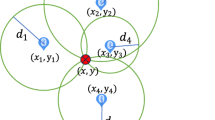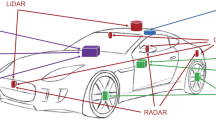Abstract
Radio frequency identification (RFID) is a technique that uses radio frequency signals to automatically position the target. RFID-based location identification based on dynamic active RFID calibration (LANDMARC) system has prominent superiority in indoor positioning of complex environment. However, the original LANDMARC algorithm has disadvantages such as few reference tags, impractical weight definition, wrong selection for neighbor tags, unreasonable layout of readers and reference tags. In the work, an improved LANDMARC system was established by using 4 readers, 4 nearest neighbors and 28 reference tags. After that, the wrong neighbor tags were judged by distance constraint. The RSSI value was divided into 128 energy levels to set weight formula of index neighbor tag, thus obtaining more ideal indoor positioning effect.








Similar content being viewed by others
References
Kaemarungsi, K., Ranron, R., Pongsoon, P. Study of received signal strength indication in ZigBee location cluster for indoor localization. In: International Conference on Electrical Engineering/electronics, Computer, Telecommunications and Information Technology, pp. 1–6 (2013)
Hazas, M., Hopper, A.: Broadband ultrasonic location systems for improved indoor positioning. IEEE Trans. Mob. Comput. 5(5), 536–547 (2006)
Rida, M. E, et al.: Indoor location position based on bluetooth signal strength. In: International Conference on Information Science and Control Engineering, pp. 769–773 (2015)
He, J., et al.: A realtime testbed for performance evaluation of indoor TOA location system. In: IEEE International Conference on Communications IEEE, pp. 482–486 (2012)
Hauschildt, D., Kirchhof, N.: Improving indoor position estimation by combining active TDOA ultrasound and passive thermal infrared localization. In: Positioning Navigation and Communication IEEE, pp. 94–99 (2011)
Hafiizh, A., Obote, S., Kagoshima, K.: DOA-RSSI Multiple Subcarrier Indoor Location Estimation in MIMO-OFDM WLAN APs Structure (2013)
Ni, L.M., et al.: LANDMARC: indoor location sensing using active RFID. Wirel. Netw. 10(6), 701–710 (2004)
Seyyedi, S., et al.: Using virtual reference tags to improve the accuracy of active RFID-based positioning systems. In: International Conference on Communication Systems and Network Technologies, pp. 1078–1081 (2014)
Jin, G. Y., Lu, X. Y., Park, M. S.: An indoor localization mechanism using active RFID tag. In: IEEE International Conference on Sensor Networks, Ubiquitous, and Trustworthy Computing, Vol. 1, IEEE Computer Society, pp. 40–43 (2006)
Yihua, H., Zongyuan, L., Ling, G.: An improved bayesian-based RFID indoor location algorithm. In: International Conference on Computer Science and Software Engineering IEEE, pp. 511–514 (2008)
Yinggang, X., et al.: Indoor location technology and its applications base on improved LANDMARC algorithm. In: Chinese Control and Decision Conference (ccdc), pp. 2453–2458 (2011)
Han, K., Cho, S. H.: Advanced LANDMARC with adaptive k-nearest algorithm for RFID location system. In: IEEE International Conference on Network Infrastructure and Digital Content IEEE Xplore, pp. 595–598 (2010)
Li, B.S., Kang, Y.: Amendment and optimization of LANDMARC localization algorithm. Comput. Appl. Softw. 33(4), 99–102 (2016)
Sabesan, S., et al.: RFID tag location systems. Phys. Chem. Chem. Phys. 6(7), 1603–1607 (2016)
Bao, W., Zhou, H., Lu, W., Xie, F.: The system of knowledge management using web based learning and education technology. Comput. Syst. Sci. Eng. 31(6), 469–473 (2016)
Zhou, Q.: Research on heterogeneous data integration model of group enterprise based on cluster computing. Clust. Comput. 19(3), 1275–1282 (2016). https://doi.org/10.1007/s10586-016-0580-y
Zhou, Q.: Multi-layer affective computing model based on emotional psychology. Electron. Commer. Res. https://doi.org/10.1007/s10660-017-9265-8 (2017)
Zhou, Q., Luo, J.: The risk management using limit theory of statistics on extremes on the big data era. J. Comput. Theor. Nanosci. 12, 6237–6243 (2015). https://doi.org/10.1166/jctn.2015.4661
Xie, J., Luo, J., Zhou, Q.: Data mining based quality analysis on informants involved applied research. Clust. Comput. 19(4), 1885–1893 (2016). https://doi.org/10.1007/s10586-016-0657-7
Zhou, Q., Luo, J.: The study on evaluation method of urban network security in the big data era. Intell. Autom. Soft Comput. https://doi.org/10.1080/10798587.2016.1267444 (2017)
Author information
Authors and Affiliations
Corresponding author
Rights and permissions
About this article
Cite this article
Cui, D., Zhang, Q. The RFID data clustering algorithm for improving indoor network positioning based on LANDMARC technology. Cluster Comput 22 (Suppl 3), 5731–5738 (2019). https://doi.org/10.1007/s10586-017-1485-0
Received:
Revised:
Accepted:
Published:
Issue Date:
DOI: https://doi.org/10.1007/s10586-017-1485-0




